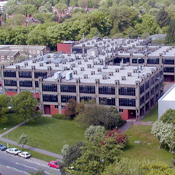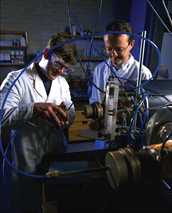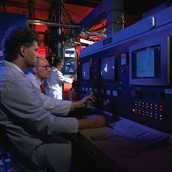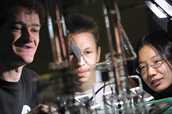 Metallurgical studies at Birmingham date back to 1881 when the first students were registered for an option in Chemistry in the Mason Science College in the City. Thirty students registered for the first course.
Metallurgical studies at Birmingham date back to 1881 when the first students were registered for an option in Chemistry in the Mason Science College in the City. Thirty students registered for the first course.
A separate Department of Metallurgy was created out of the Department of Chemistry in 1887 and this was consolidated when the College became a University in 1900. The Department moved to the Edgbaston site and Thomas Turner became the first Professor of Metallurgy in 1902.
Thomas Turner had studied under Professor Roberts-Austen at the Royal School of Mines and became a dedicated metallographer, particularly of cast iron, and Lecturer at the Mason Science College where he formed a closed friendship with Arthur Hiorns, another former RMS student, who lectured at the Birmingham and Midland Institute, the forerunner, at least metallurgically, of the University of Aston.
The Department at Birmingham in its embryonic stage started out with an interest in structural studies of load bearing materials of significant engineering interest. Other interests were metal working, in keeping with the regions activities and, of course, chemical analysis. In 1909, John Feeney, proprietor of the Birmingham Post and Mail, endowed a Chair in Metallurgy and Thomas Turner became the first Feeney Professor in 1910 (John Feeney's principal interest was in middle and far eastern metal objects and other works of art, most of which now resides in the Feeney Rooms of the Municipal Art Gallery).
Thomas Turner retired in 1926 and Daniel Hanson became the second Feeney Professor. Hanson came from N.P.L. and had interests in high temperature materials. New ways, other than light microscopy, were introduced into the Department and Tommy Wright, a Ph.D. in Physics from Sheffield, joined the staff and introduced X-rays and Crystallography. Other staff appointments followed, notably Pell-Walpole, a non-ferrous specialist, particularly in bearing metals, and Ernest Rollason, an authority on welding.
 The war years saw the activity of both staff and research students devoted to strategic metal studies. Alan Cottrell was an early war Ph.D. student and worked on welding, but there were several other government funded teams in operation; Rollason went to direct research at Murex. Towards the end of the war Hanson began putting into action his vision of Metallurgy studies for the post-war period. Alan Cottrell was brought onto the staff with the remit to develop and introduce modern science concepts into the teaching and research. He spent time with the solid state physicists both at Birmingham and Bristol and led the movement towards the physical metallurgy emphasis from 1944 onwards. Geoffrey Raynor was attracted from Oxford to develop alloy chemistry. Theoretical and Structural Metallurgy became a final year specialism course. Additions to the post-war staff in Physical Metallurgy included T. Ko, Frank Nabarro and Bruce Bilby among others.
The war years saw the activity of both staff and research students devoted to strategic metal studies. Alan Cottrell was an early war Ph.D. student and worked on welding, but there were several other government funded teams in operation; Rollason went to direct research at Murex. Towards the end of the war Hanson began putting into action his vision of Metallurgy studies for the post-war period. Alan Cottrell was brought onto the staff with the remit to develop and introduce modern science concepts into the teaching and research. He spent time with the solid state physicists both at Birmingham and Bristol and led the movement towards the physical metallurgy emphasis from 1944 onwards. Geoffrey Raynor was attracted from Oxford to develop alloy chemistry. Theoretical and Structural Metallurgy became a final year specialism course. Additions to the post-war staff in Physical Metallurgy included T. Ko, Frank Nabarro and Bruce Bilby among others.
Industrial Metallurgy continued to be developed with the appointments of Voya Kondic in casting, 'Dickie' Singer to processing and later Donald Wilson to forming studies. A new processing laboratory was built in 1948-49 with industrial sponsorship and was a showpiece for undergraduate studies and research into industrial processes. This was unique in University Metallurgy studies and a culmination of the total vision Hanson had for the breadth of Metallurgy. Leslie Aitcheson was attracted from local industry to head the revolution in Industrial Metallurgy but was only briefly Professor (1948-49) owing to ill health.
Hanson died, in post, in early 1953 and much of the impetus for integrated studies in industrial and physical metallurgy was lost. A.J. Murphy was appointed to succeed Hanson but stayed for only two years before moving to Cranfield Institute of Technology as Principal. Alan Cottrell also left in 1955 moving to A.E.R.E. Harwell as Deputy Head of Metallurgy to Monty Finneston. Rollason was then recruited to the Chair of Industrial Metallurgy in 1956 from Liverpool University and from then on the two 'wings' of the discipline were developed relatively independently. G.V. Raynor became Feeney Professor of Physical Metallurgy and E. Rollason head of Industrial.
With the 'Robbins' expansion in the early 60's, the two areas became physically separated with Physical Metallurgy moving to a new building on the Pritchatts Road site and Industrial Metallurgy remaining with the processing laboratory, named after Aitcheson, in the Aston Webb building. Ray Smallman became Professor of Physical Metallurgy in 1964. With the development of Materials, a Centre for Materials Science, largely a service and research centre with no teaching commitment was created, and Professor Alan McQuillan who had joined the Department from Australia introducing titanium studies into the research activities, became the Director. However, this development further widened the metallurgy and materials activities at the University.
 Professor Smallman succeeded to the Feeney Chair in 1969 and a more fruitful interaction with Rollason led to a School being formed in 1970 as a first step to uniting the two factions. When Rollason died in 1972 Donald Wilson was appointed Professor of Industrial Metallurgy but it was not until Donald's retirement in 1980 that the unification was completed. The Centre for Materials Science was also amalgamated in 1981 into a new Department of Metallurgy and Materials, under the Headship of Ray Smallman. Professor Tom Bell was appointed (1981) to the Hanson Chair of Industrial Metallurgy and Professor Mike Loretto to a personal chair in Materials Science (1983). Relocation of most of the former industrial staff onto the Pritchatts Road site was readily achieved but the Aitcheson Laboratory was refurbished to provide a self-contained Materials Processing laboratory serving not only Metallurgy and Materials but also other engineering departments.
Professor Smallman succeeded to the Feeney Chair in 1969 and a more fruitful interaction with Rollason led to a School being formed in 1970 as a first step to uniting the two factions. When Rollason died in 1972 Donald Wilson was appointed Professor of Industrial Metallurgy but it was not until Donald's retirement in 1980 that the unification was completed. The Centre for Materials Science was also amalgamated in 1981 into a new Department of Metallurgy and Materials, under the Headship of Ray Smallman. Professor Tom Bell was appointed (1981) to the Hanson Chair of Industrial Metallurgy and Professor Mike Loretto to a personal chair in Materials Science (1983). Relocation of most of the former industrial staff onto the Pritchatts Road site was readily achieved but the Aitcheson Laboratory was refurbished to provide a self-contained Materials Processing laboratory serving not only Metallurgy and Materials but also other engineering departments.
Since the founding of the University, all science and engineering studies were carried out in a single Faculty of Science and Engineering. In 1985 it was decided to split the faculty into Science and Engineering and the Department of Metallurgy and Materials became part of the Engineering Faculty offering B.Eng. and M.Eng. degrees.
In 1987, Professor Smallman became Vice-Principal of the University to be succeeded by Professor Loretto as head of the Department (1988) and Professor Rex Harris was given a personal chair in Materials Science. However, when the University was awarded the Interdisciplinary Research Centre in High Performance Materials, Professor Loretto moved on to become its Director and Professor John Knott came from Cambridge to be the new head of what was now the School of Metallurgy and Materials, following the setting up of Budget Centres within the University in 1988.
 Into the 1990's saw the gradual integration of processing facilities onto the Pritchatts Road site and the total removal of processing studies from the Aston Webb block. Professor Smallman formally retired in 1993 and Professor Knott became the fifth holder of the Feeney chair.
Into the 1990's saw the gradual integration of processing facilities onto the Pritchatts Road site and the total removal of processing studies from the Aston Webb block. Professor Smallman formally retired in 1993 and Professor Knott became the fifth holder of the Feeney chair.
In the Session 1995/96 Professor Knott was elected Dean and Rex Harris succeeded him as Head of the School of Metallurgy and Materials. Two new chairs were also created: Paul Bowen became Professor of Mechanical Metallurgy in 1995 and Ian Jones became Professor of Physical Metallurgy in 1996. During 1998 Stuart Abell became Professor of Functional Materials. On 1 January 2002 Paul Bowen succeeded Rex Harris as Head of School until 2016 when Professor Alison Davenport became the first female Head of School in the history of the Department.